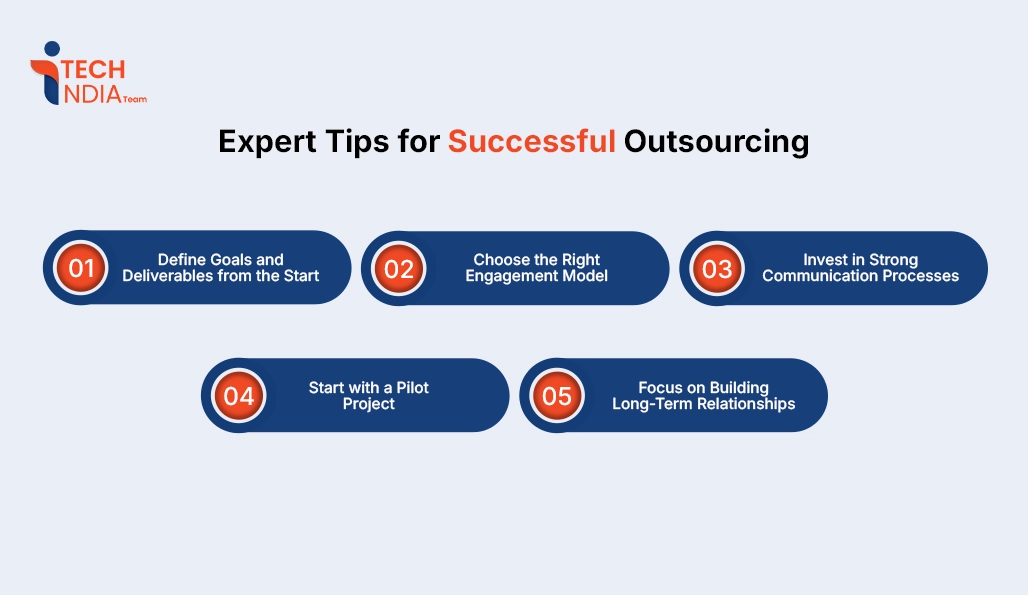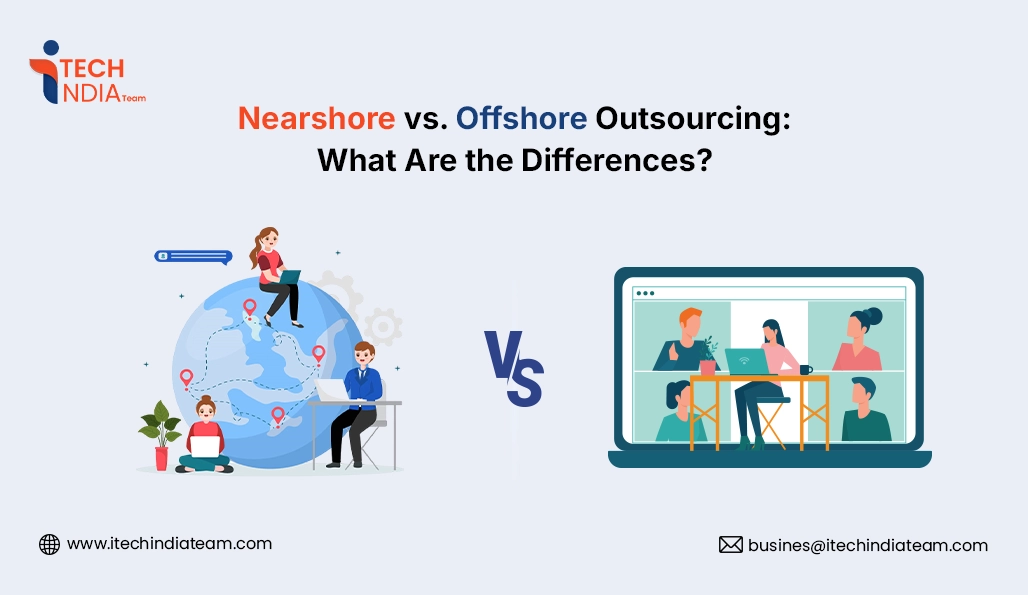Nearshore vs. Offshore Outsourcing: What Are the Differences?
Choosing Between Nearshore vs. Offshore Outsourcing for IT Projects?
Learn the key differences between outsourcing models, such as cost structures, advantages, and possible pitfalls—to create a strategy that serves your business goals.
When it’s time to scale efficiently or gain access to worldwide tech talent, the nearshore vs. offshore outsourcing choice is decisive. Both models come with pros and cons for working together, price, time zone compatibility, and cultural alignment.
In this blog, we’ll cover nearshore vs. offshore outsourcing and how these differ from one another, explained in simple and clear terms.
What Is Nearshore Outsourcing?
Nearshore outsourcing is the act of outsourcing business processes or development work to firms or experts in nearby or close nations—generally those in the same time zone. The practice fills the gap between cost cutting and easy communication, providing a middle option between onshore and offshore arrangements.
For instance, a U.S.-based company could utilize nearshore outsourcing in Mexico, Colombia, or Costa Rica, having similar work hours and cultural proximity. Nearshore outsourcing is advantageous because collaborative individuals working in the context of agile teams typically want real-time interactions.
Nearshore outsourcing is best for companies that still want to closely maintain communication and cultural synergy while minimizing some of the costs of operations. Nearshore works great for companies that want control, speed, and shared working hours in their processes for software and customer service workflows.
Note: Many of the most common nearshore development destinations are Spanish-speaking countries including Argentina, Mexico, and Colombia. This is relevant as there are many Spanish-speakers in the U.S., especially in Florida, California, and Texas. For companies looking to reach this audience, nearshoring offers a great option for customer service, virtual assistants, or a business in the Latin market.
Popular Nearshore Outsourcing Destinations:
- Mexico
- Colombia
- Argentina
- Costa Rica
- Brazil
- Chile
- Uruguay
Key Services Commonly Outsourced Nearshore:
- Software and mobile app development
- Customer service (especially bilingual/Spanish-speaking support)
- IT support and infrastructure management
- QA testing and DevOps
- Virtual assistants and administrative tasks
- Digital marketing and content creation
- Financial and accounting services
Also Read: How Much Does It Cost to Hire an App Developer in India?
What Is Offshore Outsourcing?
Offshore outsourcing is defined as outsourcing business functions – for example, software development, customer support, or IT support – to companies or people in different parts of the world, often separated by large oceans, and in many cases oceans apart from conversation time zones. The main motivation here is to achieve sizeable cost savings and to gain access to a much larger global talent pool.
For example, an American company may offshore their app development in India or the Philippines to gain access to cheaper labor and specialist technical skills. Irrespective of the location and time distance, offshore groups tend to use flexible work shifts to synchronize their work hours to match their customers’ time zones.
Popular Offshore Outsourcing Destinations:
- India
- The Philippines
- Vietnam
- Ukraine
- China
- Bangladesh
Key Services Outsourced Offshore:
- Software & app development
- Technical support and help desk
- Data processing and analytics
- Customer service and back-office operations
Offshore outsourcing is most suitable for companies that want to grow operations inexpensively, leverage international talent, and have continuous productivity. Yet, it calls for coordination, excellent project management, and communication aids to cross distances and time zones.
Key Differences of Nearshore vs. Offshore Outsourcing

When considering nearshore vs. offshore outsourcing, it pays to know the differences that exist in these two forms of outsourcing by geographic proximity, cultural compatibility, cost, methods of communication, and compliance. Below is an evaluation of each to give you the chance to consider different outsourcing locations.
1. Geographic Proximity & Time Zones
Nearshore Outsourcing:
Nearshore outsourcing is when you work with developers from countries close to your own, often only 1-3 hours apart. The benefit of nearshore outsourcing is not only the proximity to the team, but the close time difference will also help communication, time to make decisions, and also every team the opportunity to work in real time. For instance, if a company in the U.S. hires a team to develop software in Canada or Mexico, the time zones between the two ought to be directly overlapped and they should be able to make quick updates and adjustments to an issue efficiently.
| Country | Time Difference (from EST) | Notes |
| Canada | 0 to +3 hours | Seamless integration for U.S.-based teams |
| Mexico | 0 to -1 hour | Strong IT hubs in Guadalajara, Monterrey |
| Colombia | 0 hours | Same time zone as EST |
| Argentina | +1 to +2 hours | Slight difference, ideal for near real-time |
| Brazil | +1 to +2 hours | Strong in software and tech outsourcing |
| Costa Rica | -1 hour | Popular for bilingual customer service |
| Chile | +1 hour | Growing tech scene, solid infrastructure |
| Uruguay | +1 hour | Stable economy, good for agile development |
Offshore Outsourcing:
Offshore outsourcing generally means the team is far away, which could mean anywhere from Asia to Eastern Europe or Latin America, to name a few. With offshore outsourcing, often time differences are larger (often 8-12+ hours); hence, when one team is done for the day, the other is just starting the day. This distance is always a constraint, as it mandates working asynchronously, slowing exchanges, decisions and lead time to resolve issues.
Comparison Table:
| Factor | Nearshore | Offshore |
| Time Zone Difference | 1-3 hours | 8-12+ hours |
| Collaboration | Real-time | Asynchronous |
| Response Time | Immediate | Delayed |
2. Cultural Alignment
Nearshore Outsourcing:
One of the most significant aspects of ensuring that projects run smoothly is cultural alignment. For a nearshore outsourcing scenario, businesses tend to choose teams from nations whose social norms, business practices, and language are comparable to their own. This establishes a point of entry in understanding the company culture and values and requirements. In the case of U.S. firms working with teams in Latin America, for instance, both sides usually will share similar work ethics, holidays, and communication patterns, which minimize misunderstandings. Offshore Outsourcing:
Offshore Outsourcing:
Offshore outsourcing involves partnering with teams located in far-off countries, often across different continents and time zones. This model is typically chosen for its cost-saving advantages, as labor tends to be more affordable in regions like Asia or Eastern Europe.
But offshore outsourcing can have its own side of the coin problems—particularly language gap, cultural issues, and incompatible business processes. For example, if a U.S.-based company is working with an Indian development team, they can face communication delays or conflicting assumptions in terms of workflow and response cycles.
All that being said, Indian outsourcing firms have learned to adopt Western business cultures considerably, especially as a result of more than two decades of working with U.S. clients. Indian teams are now largely conversant in agile practices, English-speaking, and educated in cultural awareness and international business protocol. This transformation has served to decrease friction and enhance cooperation between continents.
3. Cost Efficiency
Nearshore Outsourcing:
Although nearshore outsourcing will not allow the same level of cost saving as offshore, it does generate substantial savings against onshore (domestic) outsourcing. Cost usually is related to the geographic proximity and like legal environments and compensation levels. For example, outsourcing a staff in Canada or Mexico might be more expensive than outsourcing to the Eastern European countries or Asia but much less than outsourcing to the U.S. developers.
Offshore Outsourcing:
Offshore outsourcing is the best when it comes to cost savings because of labor arbitrage, in which organizations leverage the advantage of cheaper salaries in nations like India, the Philippines, or Vietnam. That is why it is the cheapest of the lot, particularly for companies that must grow rapidly or operate within a constrained budget. Though cost is an overwhelming strength, organizations have to give up on some things, including simultaneous collaboration and personal meetings.
Estimated Monthly Costs by Role (USD):
| Role | U.S. (Onshore) | Mexico/Colombia (Nearshore) | India/Philippines (Offshore) |
| Software Developer | $8,000–12,000 | $3,000–5,000 | $1,500–3,000 |
| QA Tester | $6,000–8,000 | $2,000–3,500 | $1,200–2,500 |
| UI/UX Designer | $7,000–10,000 | $3,000–4,500 | $1,500–3,000 |
| Customer Support Rep | $4,000–5,500 | $1,200–2,000 | $600–1,200 |
| Virtual Assistant/Admin | $3,500–5,000 | $1,000–1,800 | $500–1,000 |
| Digital Marketer/SEO Exec | $5,000–7,000 | $2,000–3,500 | $1,000–2,500 |
| Project Manager | $8,000–12,000 | $3,500–6,000 | $2,000–4,000 |
4. Communication Barriers
Nearshore Outsourcing:
Nearshore teams usually speak a common or closely related language with the client. For example, U.S. businesses outsourcing to Latin American nations usually collaborate with Spanish-speaking teams—which suits the big Spanish-speaking population in the U.S., particularly for customer-facing functions.
Though communication tends to be smoother and quicker than it is with offshore teams, do bear in mind that English speaking levels can be varied by position and geography. English fluency is not as universally high, for example, in some of the nearshore countries, particularly in technical or back-end positions. This could cause occasional misunderstandings or requiring further onboarding or language courses.
But cultural nearness and matched work styles nonetheless retain for nearshore outsourcing its high advantage at easing friction, enhancing teamwork, and shortening project turnaround times—especially within real-time or agile settings.
Offshore Outsourcing:
Offshore teams (in particular those based in non-native English speaking countries) can be particularly vulnerable to communication challenges for a variety of reasons related to language, accents, or cultural factors. Although offshore teams typically operate in one shared business language (usually English), communication problems can still occur as a result of differences in communication styles, local dialects, or varying degrees of language competence. Therefore, organizations need to invest extra time working on detailed documentation, clarification, and alignment of processes, to ensure that the project needs are fully understood.
But it is worth mentioning here that nations like India and the Philippines have a strong advantage here.
- India brings forth a vast number of engineering graduates annually where English is predominantly the medium of instruction, particularly in STEM programs.
- The Philippines is also recognized for its robust English proficiency, especially in terms of verbal skills, and has become a U.S. hub for call centers and customer care operations.
This combination of technical expertise and English fluency makes both countries ideal offshore destinations for development work, support services, and business process outsourcing.
The largest part of American call centers actually exists in India and the Philippines because each nation boasts such massive pools of young professionals that can effortlessly get up to speed with Westernized forms of communication.
5. Regulatory & Compliance Ease
Nearshore Outsourcing:
Nearshore outsourcing offers an easier path when it comes to regulatory compliance. If a country is adjacent to another, it is typically governed by a similar legal system and will have a data protection statute. For example, U.S. companies that outsource to either Canada or Mexico can expect comparable data privacy requirements and therefore it is easier to manage challenges related to intellectual property, data security, and legal agreements.
Offshore Outsourcing:
In comparison, offshore outsourcing can involve more complex legal and compliance issues, especially when contracting with countries which have their own data protection laws, intellectual property standards, and labor laws that may differ. For example, an American company that is outsourcing work to India or the Philippines must look at and understand the legal frameworks in both countries and this is not only done at the outset of the contract, it is any part of the relationship.
Although these countries have developed in the area of outsourcing processes and legal acquaintance, it’s still necessary to seek advice from legal consultants, maintain data privacy compliance, and incorporate strong IP protection clauses in the agreement.
From a business-friendliness point of view, India is highly ranked among offshore locations. Based on the World Bank’s most recent “Ease of Doing Business” rankings (before its suspension in 2020):
- India ranked 63rd in the world, indicating considerable gains in terms of contract enforcement, starting a business, and resolving construction permits.
- In comparison, most Latin American nearshoring locations such as Mexico (60th), Colombia (67th), and Argentina (126th) differ in ease of doing business rankings—i.e., legal certainty and ease of setting up business may contrast starkly among nearshore alternatives.
Read Also: Outsourcing to India: Why it is the Right Choice
Which Is Right for Your Business?
Through extensive research, surveys, and firsthand experiences shared by global users, we’ve identified key patterns in the nearshore vs. offshore outsourcing debate. The right choice ultimately depends on your priorities—whether it’s cost-efficiency, speed, communication, or talent access.
Choose Nearshore Outsourcing If:
- You prioritize smoother communication and time zone alignment. Teams in similar time zones enable real-time collaboration. One startup founder noted,
- “We switched to nearshore after struggling with overnight delays—it changed everything. Now we work like one team.”
- Cultural compatibility matters. Shared work culture, language fluency, and expectations reduce misunderstandings and speed up onboarding. As one user shared,
- “With our nearshore team, things just clicked. They understood our design references and product goals without constant back-and-forth.”
- You need high involvement and agile sprints. Nearshore teams are ideal for businesses that iterate quickly and need developers to join standups or workshops regularly.
That said, nearshore can be slightly more expensive than offshore, especially in regions like Latin America, where demand is growing. But many companies view this as a worthwhile trade-off for collaboration and alignment.
Choose Offshore Outsourcing If:
- Cost savings are your top priority. Offshore locations like India, the Philippines, and parts of Southeast Asia offer access to experienced developers at a fraction of the cost. One business owner stated,
- “For our MVP, offshore was a no-brainer. We got solid output for a third of the cost we’d pay locally.”
- You’re focused on results, not real-time interaction. If your workflow allows for asynchronous communication, offshore teams can deliver high-quality work overnight—ideal for fixed-scope projects.
- You’re looking to scale fast with a tight budget. Several users highlighted how offshore partners helped them scale development teams quickly.
- “We needed to build fast but couldn’t afford local talent. Our offshore partner gave us access to a full-stack team in two weeks,” one founder explained.
Challenges such as time zone gaps, communication delays, and occasional quality concerns were noted. However, those who set clear expectations, defined processes, and used collaborative tools like Slack and Jira reported smoother experiences.
A Balanced Insight:
Some businesses combined both approaches. One user shared,
“We manage product strategy and UI design in-house, use nearshore for core development, and offshore for testing. It’s more complex but gives us the best of all worlds.”
Expert Tips for Successful Outsourcing

When exploring nearshore vs. offshore outsourcing, the decision goes beyond geography or cost—it’s about building a successful, results-driven partnership. Here are five expert-backed tips to ensure your outsourcing experience delivers long-term value and high performance:
1. Define Goals and Deliverables from the Start
Transparency is the basis of any effective outsourcing effort. Define explicitly what your project will deliver, along with particular milestones, timelines, and performance measures. This creates realistic expectations on both sides and minimizes confusion. Working either with a nearshore group in a neighboring time zone or an offshore ally in another country, clear documentation simplifies communication and execution.
2. Choose the Right Engagement Model
Your project flexibility and business objectives should determine your choice of engagement model. Fixed-price models are suitable for short-term, well-defined work, whereas time-and-material or dedicated team models are more appropriate for changing or complicated projects. In the case of nearshore vs. offshore outsourcing, nearshore teams can be more suitable for agile and rapid development, whereas offshore models tend to be less expensive for large-scale builds with stable requirements.
3. Invest in Strong Communication Processes
Communication is among the largest sources of success. Hold regular sync-ups, leverage collaboration software such as Slack, Zoom, and Trello, and maintain current documentation. Nearshoring usually means real-time discussion and immediate feedback with overlapping time zones. Offshore might take more structured, asynchronous communication—but with the right planning, it can be every bit as successful.
4. Start with a Pilot Project
Instead of leaping into a full-development contract, start with a pilot project that’s small and easy to manage. This provides an opportunity to test the vendor’s technical capabilities, communication approach, and general fit with your work culture. Particularly when nearshore vs. offshore outsourcing is a consideration, a pilot can expose which model works best with your expectations.
5. Focus on Building Long-Term Relationships
Successful outsourcing extends beyond transactional work. Consider your outsourced team as strategic partners—engage them in conversations, communicate your vision, and foster collaboration. Teams that feel committed to your business objectives tend to produce superior results. This relationship-first approach applies to both nearshore and offshore models, which facilitates a shared sense of ownership and accountability.
Conclusion:
The decision between Nearshore vs. Offshore Outsourcing depends on your business priorities. Nearshore outsourcing offers closer time zones, cultural alignment, and smoother communication—ideal for agile projects requiring real-time collaboration. Offshore outsourcing, on the other hand, it maximizes cost savings and access to global talent but requires strong project management to overcome time zone and cultural barriers.
For startups and businesses needing quick iterations, nearshore is often the better fit. Larger enterprises focused on scaling affordably may prefer offshore. Some companies even blend both models for optimal results. By evaluating factors like cost, communication, and compliance, you can choose the best outsourcing strategy to drive efficiency and growth.
Ultimately, success hinges on clear goals, strong partnerships, and the right balance between savings and collaboration.

Pankaj Arora (Founder & CEO)
Pankaj Arora is the Founder & CEO of iTechGen, a visionary leader with a deep passion for AI and technology. With extensive industry experience, he shares expert insights through his blogs, helping businesses harness the power of AI to drive innovation and success. Committed to delivering customer-first solutions, Pankaj emphasizes quality and real-world impact in all his endeavors. When not leading iTechGen, he explores emerging technologies and inspires others with his thought leadership. Follow his blogs for actionable strategies to accelerate your digital transformation and business growth.
View More About Pankaj Arora







